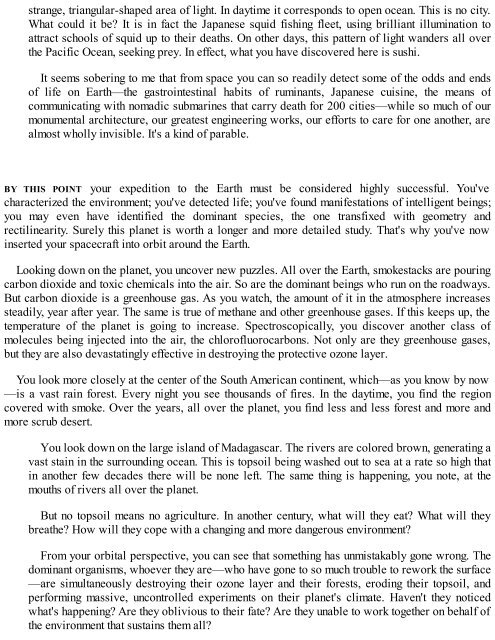Pale Blue Dot ( PDFDrive.com ) (1)
Create successful ePaper yourself
Turn your PDF publications into a flip-book with our unique Google optimized e-Paper software.
strange, triangular-shaped area of light. In daytime it corresponds to open ocean. This is no city.<br />
What could it be? It is in fact the Japanese squid fishing fleet, using brilliant illumination to<br />
attract schools of squid up to their deaths. On other days, this pattern of light wanders all over<br />
the Pacific Ocean, seeking prey. In effect, what you have discovered here is sushi.<br />
It seems sobering to me that from space you can so readily detect some of the odds and ends<br />
of life on Earth—the gastrointestinal habits of ruminants, Japanese cuisine, the means of<br />
<strong>com</strong>municating with nomadic submarines that carry death for 200 cities—while so much of our<br />
monumental architecture, our greatest engineering works, our efforts to care for one another, are<br />
almost wholly invisible. It's a kind of parable.<br />
BY THIS POINT your expedition to the Earth must be considered highly successful. You've<br />
characterized the environment; you've detected life; you've found manifestations of intelligent beings;<br />
you may even have identified the dominant species, the one transfixed with geometry and<br />
rectilinearity. Surely this planet is worth a longer and more detailed study. That's why you've now<br />
inserted your spacecraft into orbit around the Earth.<br />
Looking down on the planet, you uncover new puzzles. All over the Earth, smokestacks are pouring<br />
carbon dioxide and toxic chemicals into the air. So are the dominant beings who run on the roadways.<br />
But carbon dioxide is a greenhouse gas. As you watch, the amount of it in the atmosphere increases<br />
steadily, year after year. The same is true of methane and other greenhouse gases. If this keeps up, the<br />
temperature of the planet is going to increase. Spectroscopically, you discover another class of<br />
molecules being injected into the air, the chlorofluorocarbons. Not only are they greenhouse gases,<br />
but they are also devastatingly effective in destroying the protective ozone layer.<br />
You look more closely at the center of the South American continent, which—as you know by now<br />
—is a vast rain forest. Every night you see thousands of fires. In the daytime, you find the region<br />
covered with smoke. Over the years, all over the planet, you find less and less forest and more and<br />
more scrub desert.<br />
You look down on the large island of Madagascar. The rivers are colored brown, generating a<br />
vast stain in the surrounding ocean. This is topsoil being washed out to sea at a rate so high that<br />
in another few decades there will be none left. The same thing is happening, you note, at the<br />
mouths of rivers all over the planet.<br />
But no topsoil means no agriculture. In another century, what will they eat? What will they<br />
breathe? How will they cope with a changing and more dangerous environment?<br />
From your orbital perspective, you can see that something has unmistakably gone wrong. The<br />
dominant organisms, whoever they are—who have gone to so much trouble to rework the surface<br />
—are simultaneously destroying their ozone layer and their forests, eroding their topsoil, and<br />
performing massive, uncontrolled experiments on their planet's climate. Haven't they noticed<br />
what's happening? Are they oblivious to their fate? Are they unable to work together on behalf of<br />
the environment that sustains them all?


